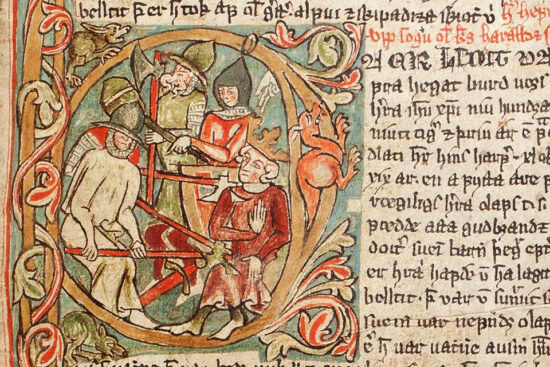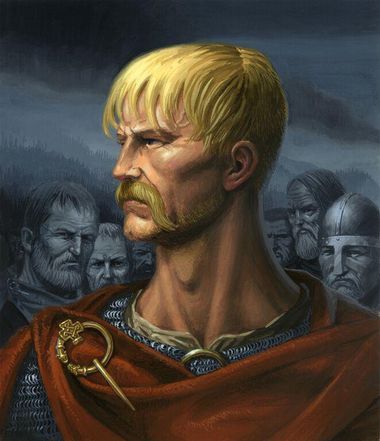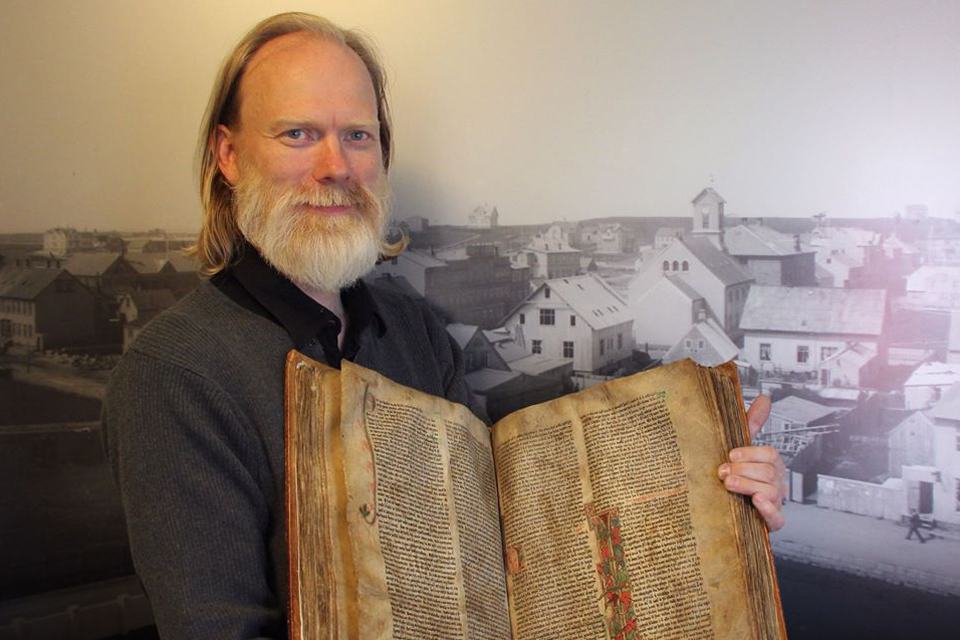A translation and edition of the Flateyjarbok from 1387 was recently completed. An English translation is hopefully on the way.

The Flateyjarbok from 1387-1394 is arguably one of the grander manuscripts ever created on Iceland. Comprising 202 tightly written and illuminated vellum leaves, it tells the story of the Norse kings but expanded with material not found in Snorre’s Heimskringla. The manuscript also contains poems and short stories not preserved elsewhere. Included is also the history of the Greenlanders, the Orkney and the Faroe Islands. The book is unique for telling in details about its first owner, Jón Hákonarson and its compilers and authors, Jón Thordarson and Magnus Thórhallsson. Scholars still debate who was the main editor. The illuminations were done by Thórhallsson.
Jón Hákornason was a wealthy farmer, who lived in Víðidalstunga in Hunavatnssyslain Northwestern Iceland. Later, Thorleif Björnsson owned the book. He added the final 23 pages at the end.
It has been suggested that the Flateyjarbok was intended as a ” Speculum regale” to the Norwegian king, Oluf Hakonarson. However, he died in 1394, and the book remained in Iceland until 1616, when the bishop acquired the manuscript and gifted it to the King of Denmark. Today, the manuscript is preserved in Iceland. For centuries, though, it was kept in the Royal Library in Copenhagen.

As a collection of texts, bits and pieces have been published in numerous editions and contexts. A full edition, however, has been few and far between. Already in the 17th century, a Danish translation was produced by Tormod Torfæus (1636 -1711). This translation was never printed. The book was partly published in three volumes in 1860 – 68 by C. R. Unger and Gudbrandur Vigfússon in Norway, while a full edition in Norse was published by Sigurður Nordal in Reykjavík in 1944-45 , When Iceland was celebrating its independence. Complete translations into modern languages have so far not been available.
Since 2011 a group of dedicated scholars, editors and translators have worked to publish a complete edition of the Flateyjarbok in Norwegian. Recently the sixth and last volume was published in a luxurious edition with a foreword of the Norwegian King Harold and the Danish Queen Margaret. Generously illustrated by the artist, the edition is intended as a monument to the national history of Norway. With the last volume having been finally published in December 2019, the group is now moving on to the next project: a full English edition planned to be completed in 2022.
SOURCE:
Flateyjarbók GKS 1005 fol.
The Árni Magnússon Institute for Icelandic Studies
Flateyjarbók inniheldur konungasögur og þætti auk nokkurra kvæða.
Iceland, 1387-1394
List of contents
READ MORE:
The Development of Flateyjarbók Iceland and the Norwegian Dynastic Crisis of 1389
By Elizabeth Ashman Rowe
Series: The Viking Collection vol. 15
University Press of Southern Denmark 2005
EDITION
Flatøybok. Stavanger
Ed by Torgrim Titlestad et al with a translation by Edvard Eikill, Børge Nordbø andMichael Males; and illustrations by Anders Kvåle Rue.
Norway: Saga Bok. 2014–2019. ISBN 978-82-91640-99-0
FEATURED PHOTO
Anders Kvåle Rues presenting the Flateyjarbok in Reykjavik. Source: FB Sagabok
SEE MORE:
FOLLOW THE PROJECT
